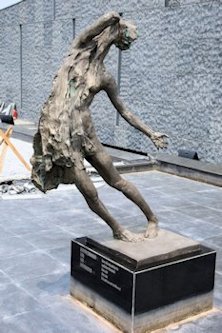
|
Nanjing Massacre Museum 4. Outdoor Exhibit
Over 20,000 women were raped, and many were then killed. About one third of the
structures in the city were burned down. Countless shops, stores, and
residences were looted and sacked. Corpses littered the streets and were seen
afloat on rivers for weeks. Even children, the elderly, and nuns suffered at
the hands of the Japanese army. An estimated 300,000 civilians and unarmed
Chinese soldiers were brutally slaughtered by beheading, burying alive, or
burning the victims. Japanese soldiers were also reported to have conducted
killing competitions and bayonet practice using live Chinese prisoners.
Hi-Res Pic (149K) Return to Nanjing Massacre Scenes Page 1 History of the Nanjing Massacre |